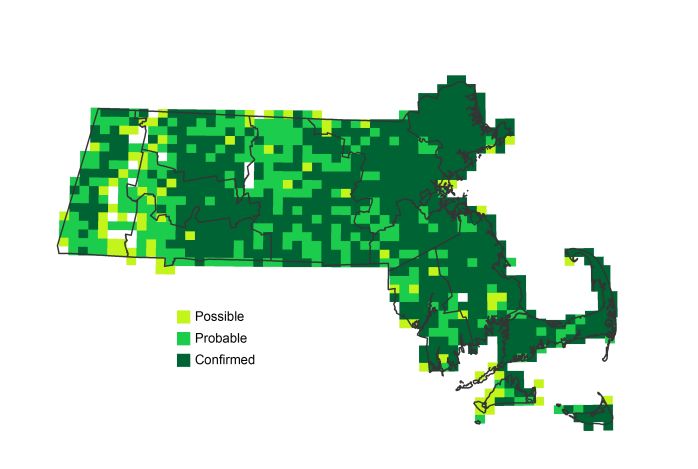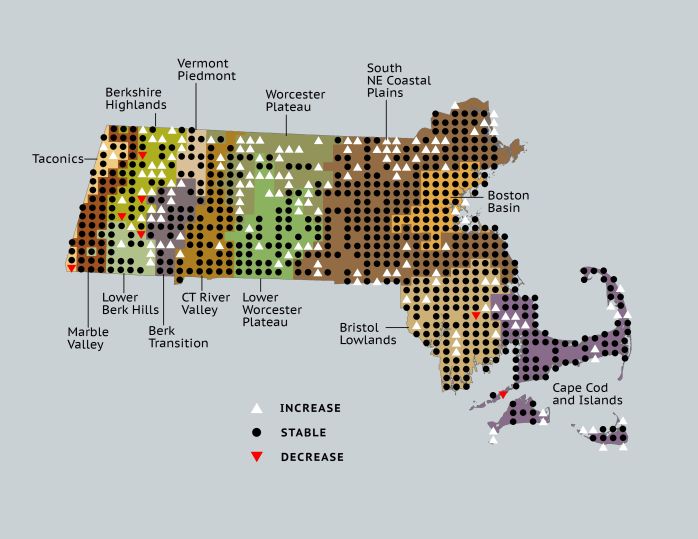Find a Bird
Northern Cardinal
Cardinalis cardinalis

Nearly ubiquitous and likely increasing

“We have all, at one time or another, been performers, and many of us still are – politicians, playboys, cardinals, and kings.” – Sir Laurence Olivier
Despite the somewhat-misleading common name, the Northern Cardinal was a “southern” species as recently as 100 years ago. Historically, its center of distribution rested squarely in the American Southeast, where this mostly nonmigratory species dwelled in brushy clearings and second-growth forests. Life in farmlands and the suburbs proved agreeable to the Northern Cardinal, and it established itself as a familiar face in towns and homesteads. The ability to “make a living” in human-altered landscapes has been at least partly responsible for the extraordinary spread of this species.
Historic Status
The Cardinal Grosbeak, or Redbird as it was formerly called, was kept as a cage bird for centuries before it reached Massachusetts on its own. William Peabody recorded appearances of cardinals at “irregular intervals, in the villages on Connecticut River” in the 1830s, and this pattern persisted for more than a century (Peabody 1839). The first Northern Cardinal nest ever found in the state was discovered in 1898 in Brookline (Forbush 1929). This was likely the result of a wild bird and an escaped cage bird successfully finding one another and then nesting. The first bona fide wild nesting in Massachusetts did not occur until 1958 (Boyd 1962). Throughout the 1960s, the species continued its northward expansion in the eastern half of the country.
Atlas 1 Distribution
By the time Atlas 1 surveys were underway, the once-rare Northern Cardinal had become commonplace in Massachusetts, and they graced the Commonwealth with 73% block occupancy. No less beautiful for their familiarity, cardinals could be found in backyards and edge habitats all across the Commonwealth. While quite widespread in the Taconics and omnipresent in the Marble Valleys, cardinals were absent from parts of the Berkshire Highlands and Lower Berkshire Hills. Although breeding cardinals were heavily concentrated east through the Connecticut River Valley, they were conspicuously absent from much of the forested Worcester Plateau. Not surprisingly, the more suburbanized areas of the Coastal Plains and much of the Boston Basin had cardinals aplenty. The species remained very widespread, if not nearly ubiquitous, as a breeder throughout the Bristol/Narragansett Lowlands and the Cape and Islands.
Atlas 2 Distribution and Change
The red mantle of the male Northern Cardinal along with its dusty-rose-colored mate was observed in suburban backyards of the Commonwealth more than ever by the time of Atlas 2, reaching an impressive 94% block occupancy. The increase and spread of this species has all the hallmarks of many of the other successful colonizers – persistence in Atlas 1 blocks, creeping expansion all across the state, and consolidation of their range. Regardless of its absence from only some of the highest reaches of Massachusetts, it is difficult to imagine that this species first reached the Commonwealth only as recently as 1958.
Atlas 1 Map

Atlas 2 Map

Atlas Change Map

Ecoregion Data
Atlas 1 | Atlas 2 | Change | ||||||
Ecoregion | # Blocks | % Blocks | % of Range | # Blocks | % Blocks | % of Range | Change in # Blocks | Change in % Blocks |
Taconic Mountains | 14 | 87.5 | 2.0 | 18 | 72.0 | 1.8 | 1 | 6.7 |
Marble Valleys/Housatonic Valley | 39 | 100.0 | 5.5 | 39 | 100.0 | 4.0 | 0 | 0.0 |
Berkshire Highlands | 29 | 52.7 | 4.1 | 46 | 83.6 | 4.7 | 16 | 30.2 |
Lower Berkshire Hills | 18 | 64.3 | 2.6 | 23 | 74.2 | 2.4 | 3 | 11.1 |
Vermont Piedmont | 14 | 82.4 | 2.0 | 17 | 100.0 | 1.7 | 0 | 0.0 |
Berkshire Transition | 24 | 63.2 | 3.4 | 39 | 97.5 | 4.0 | 9 | 29.0 |
Connecticut River Valley | 51 | 91.1 | 7.2 | 65 | 100.0 | 6.7 | 4 | 8.3 |
Worcester Plateau | 24 | 30.8 | 3.4 | 87 | 98.9 | 8.9 | 27 | 56.3 |
Lower Worcester Plateau | 48 | 64.9 | 6.8 | 77 | 96.3 | 7.9 | 13 | 24.1 |
S. New England Coastal Plains and Hills | 210 | 77.8 | 29.8 | 279 | 98.6 | 28.6 | 39 | 17.3 |
Boston Basin | 49 | 87.5 | 7.0 | 53 | 94.6 | 5.4 | 3 | 5.5 |
Bristol and Narragansett Lowlands | 92 | 86.8 | 13.1 | 107 | 93.9 | 11.0 | 10 | 9.9 |
Cape Cod and Islands | 92 | 67.6 | 13.1 | 126 | 87.5 | 12.9 | 19 | 15.8 |
Statewide Total | 704 | 72.7 | 100.0 | 976 | 94.1 | 100.0 | 144 | 17.4 |
Notes
The Northern Cardinal shows a significant increasing Breeding Bird Survey trend in Massachusetts, in the New England/Mid-Atlantic Region, and in the Eastern US overall. Interestingly, many other southern colonizers have patterns similar to those of the Northern Cardinal. The Cooper’s Hawk, Red-bellied Woodpecker, Tufted Titmouse, and Carolina Wren, while different in many ways from the cardinal, have also shown this same ability to push their range rapidly northward.



